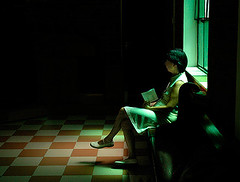RT's Guidelines in Lighting and Composition . . .
Ambient light is also known as Available light; it is what's there when you arrive. In C-4 the ambient light is a combination of flourescent and daylight.
Frontal light is usually provided by the flash unit.
* It is often a useful light, filling in untoward shadows and freezing the subject in place.
* It can also cause overexposure (too much light).
Side light is the professional's choice.
* It brings out the form's contours.
* It is indirect and flattering.
* Place your subject next to a window or move a lamp beside your subject to create side light.
Glamor Lighting, or rim lighting, is essentially back light.
* Confers upon the subject an aura of status and excitement.
* Light comes from a) above and b) behind the subject. See publicity pictures of celebrities.
* Strong light coming from behind the subject can a) separate the subject from the background
b) create a glamor effect
c) leave the front or face of the subject underexposed - be careful!
Rembrandt lighting comes from the side and above the subject's visage. It is romantic and dramatic. Study the paintings of the Dutch master to analyze and learn this style.
Composition
The S-curve: almost every element in nature - the beach, the human form - is composed of pleasing curves. Emphasize them for maximum appeal.
Rule of Thirds: divide your rectangular image field by 3 horizontal lines, equidistant, and 3 vertical lines. Place the strongest elements of your composition within the outer blocks. Designers say your composition will be more pleasing if it is not centered.
Red sweater effect: provide a center of interest for the viewer's eye by having one element that is brighter than the rest. Imagine the way that a person in a yellow or red sweater stands out from the crowd.
Get close. Bring the viewer more of the subject's personality, more of their face, their eyes, their expression, by getting close.
Cropping is cutting off parts of the subject that you feel are unnecessary. It flows with Getting Close.
Link the bodies: bring life to a group composition by having everyone crowd together and throw their arms across each other. It adds humor, smiles, and zest.
Use props: hats, sunglasses, beanie babies, crazy clothing, makeup, background music; a subject can be jazzed by the use of props.
Kapture kinetic energy: shoot to catch the action. Allow blur in the subject or background to imply movement.
Decisive moment: catch the peak of the action.
Vary the POV (point of view): shoot from high above your subject. Sometimes shoot while lying on your belly like a reptile.
When you know the rules and have demonstrated competency in them you can break the rules with comfort.
Monday, January 23, 2006
Subscribe to:
Post Comments (Atom)


No comments:
Post a Comment